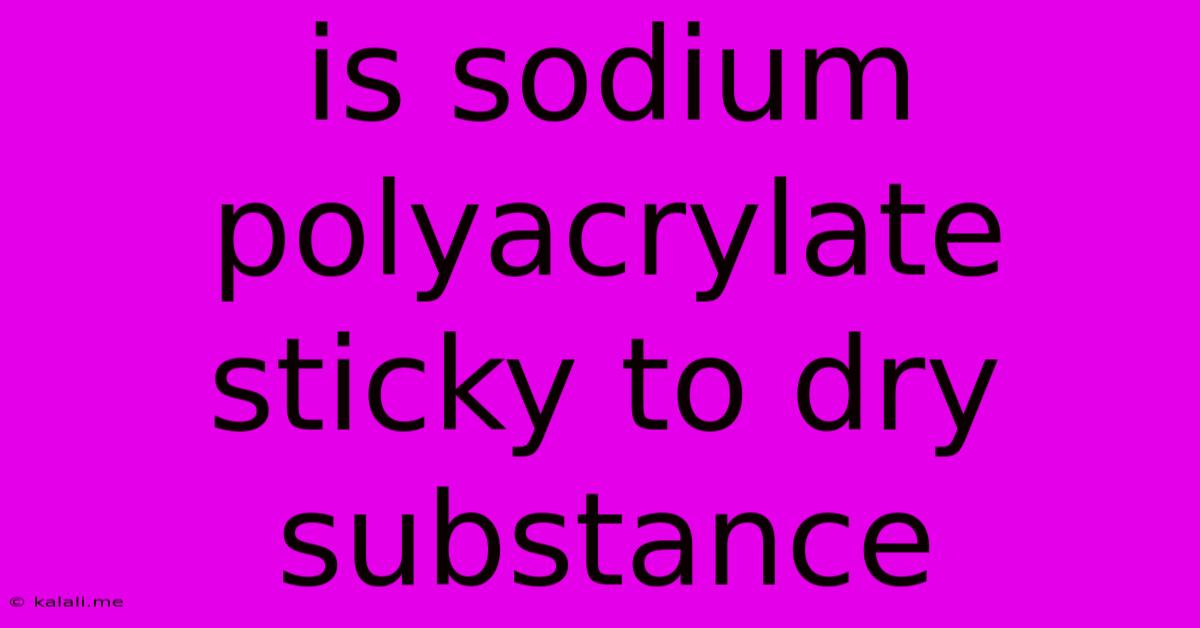Is Sodium Polyacrylate Sticky To Dry Substance
Kalali
Jun 05, 2025 · 3 min read

Table of Contents
Is Sodium Polyacrylate Sticky to Dry Substances? A Deep Dive into Superabsorbent Polymer Behavior
Meta Description: Discover the truth about sodium polyacrylate's stickiness to dry substances. This article explores its absorbent properties and how it interacts with various dry materials, providing a comprehensive understanding of its behavior. Learn about factors influencing adhesion and practical applications.
Sodium polyacrylate, a superabsorbent polymer (SAP), is renowned for its incredible ability to absorb and retain large quantities of liquid. But what about its interaction with dry substances? Is sodium polyacrylate sticky to dry materials? The answer, like many things in science, is nuanced and depends on several factors. This article explores the complexities of this interaction.
Understanding Sodium Polyacrylate's Properties
Before diving into its stickiness, let's revisit sodium polyacrylate's fundamental properties. This synthetic polymer is composed of long chains of sodium acrylate molecules. These chains are highly hydrophilic, meaning they have a strong attraction to water molecules. When exposed to liquid, these chains unravel, creating a three-dimensional network that traps the water within its structure. This explains its impressive absorbency.
Stickiness: A Matter of Surface Tension and Hydration
The stickiness of sodium polyacrylate to dry substances isn't a simple yes or no answer. It primarily depends on the surface tension of the dry material and the degree of hydration of the SAP. A completely dry sodium polyacrylate will have minimal stickiness. However, even a small amount of moisture can dramatically change its behavior.
-
Hydrated SAP: When the sodium polyacrylate absorbs moisture (even from the air), it swells and becomes gelatinous. This gelatinous state can exhibit some stickiness, particularly to materials with high surface area or porous structures like powders. The degree of stickiness will depend on the amount of absorbed moisture.
-
Dry Substances: The nature of the dry substance is crucial. Fine powders like flour or talc might adhere to a hydrated SAP due to their large surface area and potential for capillary action, drawing the swollen polymer into their crevices. However, larger, smoother, less porous substances will have less interaction.
Factors Influencing Adhesion
Several factors influence the degree of adhesion between sodium polyacrylate and dry substances:
- Moisture Content: As previously mentioned, the presence of moisture is a major factor. Higher moisture content leads to greater swelling and potentially increased stickiness.
- Particle Size and Surface Area: Fine powders have a larger surface area, increasing the points of contact and adhesion.
- Material Composition: The chemical composition and surface properties of the dry substance will affect how well it interacts with the hydrated SAP.
- Pressure and Contact Time: Applying pressure and increasing contact time can enhance adhesion, particularly with porous materials.
Practical Applications and Considerations
Understanding the stickiness of sodium polyacrylate to dry substances has practical implications across several applications:
- Diapers and Sanitary Products: The interaction between SAP and dry materials is relevant in the design and performance of absorbent hygiene products.
- Agriculture: In agriculture, SAP is used to retain moisture in soil. Understanding its interaction with soil particles is crucial for effective water management.
- Industrial Applications: Sodium polyacrylate finds use in various industrial settings, and the potential for adhesion to dry components needs to be considered for optimal performance.
Conclusion
While sodium polyacrylate isn't inherently "sticky" in its dry state, its interaction with dry substances becomes more complex when moisture is involved. The degree of stickiness depends on factors like moisture content, the properties of the dry substance, and the level of interaction. Considering these factors is crucial for understanding and managing the behavior of sodium polyacrylate in various applications.
Latest Posts
Latest Posts
-
This Is Just To Say Chartlit
Jun 06, 2025
-
Check If Argument Is Passed In Korn Shell
Jun 06, 2025
-
How Did Joseph Die In The Bible
Jun 06, 2025
-
Dnd Casting Concentration Spells On Allies 5e
Jun 06, 2025
-
How Long Can Cooked Chicken Stay Out Of The Fridge
Jun 06, 2025
Related Post
Thank you for visiting our website which covers about Is Sodium Polyacrylate Sticky To Dry Substance . We hope the information provided has been useful to you. Feel free to contact us if you have any questions or need further assistance. See you next time and don't miss to bookmark.